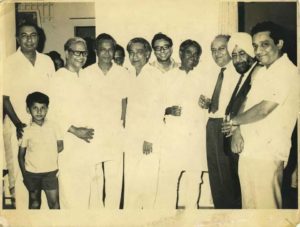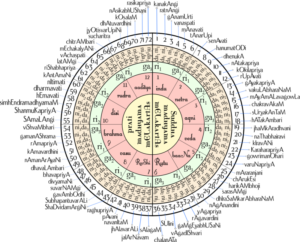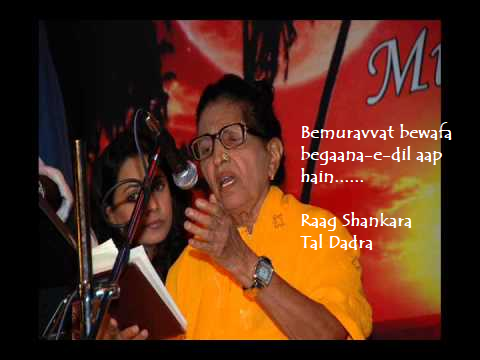Raaga Based Song of the Day: Bemuravvat bewafa begaana-e-dil aap hain….
Raag Shankara, Tal Dadra

Third consecutive day of another new Raag. Since the time I have discovered raaga based songs, I like composition of songs by various music directors in Hindi films. However, I am primarily a Lyrical man. On Facebook, I run a page titled ‘Lyrical‘. This song has been penned by Jaan Nisar Akhtar and is indeed one his best. It is also one of the best of the singer Mubarak Begum.
We have completed sixty-nine days of Raaga Based Songs of the Day. Our first post in the series was titled ‘Raaga Based Song Of The Day #1’ and the song was a Mohammad Rafi and Lata Mangeshkar song from the 1970 Shakti Samanta movie Pagla Kahin Ka: Tum mujhe youn bhula na paoge. It is in Raag Jhinjhoti, Tal Kaherava.
Our sixty-ninth post or the last post was titled ‘Raaga Based Song Of The Day #69‘ and the song was a Suresh Wadkar song from the 1984 Girish Karnad movie (Shashi Kapoor production) starring starring Rekha , Shekhar Suman, Shashi Kapoor, Shankar Nag, Amjad Khan and Anuradha Patel: Sanjh dhale gagan tale hum kitane ekaki. It is in Raag Vibhas, Tal Kaherava.
This blog has a number of posts on Raaga based songs in Hindi movies titled similarly; for example: ‘The Best Raaga Based Songs in Hindi Movies – Raaga Pilu – Part I‘.
In the last sixty-nine days of sharing Raaga based songs of the day, I have given you songs based on Raag Jhinjhoti, Gara, Bhimpalasi, Madhuvanti, Shivaranjani, Bihag, Pahadi, Sarang, Pilu, Bhairavi, Khammaj, Charukesi, Kalyan or Yaman, Desh, Malgunji, Kirwani, Kedar, Bageshri, Megh Malhar, Bhupali, Ahir Bhairav, Malkaush, Mand, Adana, Kafi, Rageshri, Jaunpuri, Tilang, Janasammohini, Chayanat, Shuddha Kalyan, Gaur Sarang, Jogiya, Asavari, Maru Bihag, Durga, Lalit, Puria Dhanashri, Bhinna Sahdja, Sohani, Multani, Patdeep, Jaijaiwanti, Tilak Kamod, Hemant, Basant Mukhari, Gujri Todi, Kalavati, Hamir, Bhatiyar, Gawati, Shyam Kalyan, Gorakh Kalyan, Madhamat Sarang, Manj Khammaj, Darbari Kanada and Vibhas. The six raagas that have been repeated so far are Pahadi, the raaga of my home place in the Himalayas, Maru Bihag, Raag Kirwani, Jhinjhoti, Bhairavi, and Gara. Today, I am giving you a new Raag Shankara. That makes it a total of 58 raagas so far.
Today’s song has been sung by Mubarak Begum on the lyrics of Jaan Nisar Akhtar and on a composition by C Arjun. As I said, it is in Raag Shankara, Tal Dadra.
However, first, lets take up the value added learning of today. Today, we shall learn about Melakarta.
I introduced you to Melakartha or Melakarta when I told you about Carnatic Music (Please see: ‘Raaga Based Song Of The Day #62‘). Melakarta is a collection of fundamental raagas (musical scales) in Carnatic music (South Indian classical music). Melakarta raagas are parent ragas (hence known as janaka ragas) from which other ragas may be generated. A melakarta raga is sometimes referred as mela, karta or sampurna as well, though the latter term is inaccurate, as a sampurna raga need not be a melakarta (take the raga Bhairavi, for example).
It would be easy to guess that it is similar to Thaat in Hindustani music.
I had also told you that there are 72 Melakarta raagas whereas Bhatkhande brought down the number of Thaats to merely 10.
Ragas must contain the following characteristics to be considered Melakarta.
- They are sampurna raagas – they contain all seven swaras (notes) of the octave in both ascending and descending scale.
- They are krama sampurna raagas – that is the sequence is strictly ascending and descending in the scales, without any jumps or zig-zag notes.
- The upper shadjam is included in the raaga scale. (raagas like Punnagavarali and Chenchurutti are not melakarta as they end with nishadam)
- The ascending and descending scales must have the same notes.
The mela system of ragas was first propounded by Raamamaatya in his work Svaramelakalanidhi, c. 1550. He is considered the father of mela system of ragas. Later, Venkatamakhin, a gifted musicologist in the 17th century, expounded a new mela system known today as melakarta in his work Chaturdandi Prakaasikaa. He made some bold and controversial claims and defined somewhat arbitrarily 6 swaras from the known 12 semitones, at that time, to arrive at 72 melakarta ragas.

A hundred years after Venkatamakhin’s time the Katapayadi sankhya rule came to be applied to the nomenclature of the melakarta ragas. The sankhya associates Sanskrit consonants with digits. The digits corresponding to the first two syllables of the name of a raga, when reversed, give the index of the raaga. Thus the scale of a melakarta raga can be easily derived from its name.
For example, Harikambhoji raaga starts with syllables Ha and ri, which have numbers 8 and 2 associated with them. Reversing them we get 28. Hence Harikambhoji is the 28th melakarta raaga. Have a look at the attached picture to understand it more.
As I mentioned, today’s song is composed in Raag Shankara, Tal Dadra.
Raag Shankara belongs to the Bilawal Thaat, the most basic of the ten thaats, which are, according to Vishnu Narayan Bhatkhande, the basis of almost all raagas in Indian Classical Music. Why is it most basic? Simple, Bilawal is the thaat that has all swars (notes) shuddha or in their natural scale. Raagas based on Bilawal are generally rich and sensuous. The Jati of Raag Shankara is Audhav-Shadhav Vakra, that is, five notes in Aaroha (Rishabh and Madhyam Varjya) and six notes in Avaroha (Madhyam Varjya). Dhaivat note is weak, ie, occasional.
Shankara, as you would have guessed it, is an epithet of Lord Shiva whose primal association with music & dance have long been a source of inspiration to Indians. The image of Shiva as Nataraja has moved millions of hearts and fired the imagination of artists through the ages. This leitmotif is a powerful stimulus to many an intoxicated soul, a spoor to the creative impulse as it searches for the ideal sounded in the famous apothegm: Satyam Shivam Sundaram (Truth Divinity Beauty).
Raga Shankara’s immense popularity and prestige derive not merely from a share in the Lord’s name. The raaga is the musical embodiment of His personality, comporting with all its attributes: raudra, veera, irrascible, volatile, capricious and, above all, cool. Veer-Rasa (Raudra Roop for Tandav of Lord Shankara) is the best expression of this Raag. You wake up from a stupor or disturbed state of mind upon hearing this Raag which implies as surge of the life force with the sharp rather bold pronunciation of notes in this melody.
The time for rendering this raag is the last phase of night.
Other songs composed in Raag Shankara are: Bolo bolo Kanha bolo chhaliya (Tal Dadra; sung by Runa Laila in 1960 movie Chhaliya), Desh pradesh (Tal Kaherava; sung by Kishore Kumar in 1978 movie Desh Pradesh), and Rumjhuma rumjhuma chala tihari (Tal Tintal; sung by KL Saigal in 1943 movie Tansen).
The song Bemuravvat bewafa begaana-e-dil aap hain is from the 1966 Mahendra Pran movie Sushila about which nothing much is known except that the movie had two other songs that were excellent: Gham ki andheri raat mein sung by Talat Mahmood and Mohammad Rafi, and Nazar nawaz nazaron mein kho gaya hoon main sung by Mahendra Kapoor.
All the song were penned by Jan Nisar Akhtar and composed by C Arjun.
Please enjoy in Raag Shankara, Tal Dadra: Bemuravvat bewafa begaana-e-dil aap hain…….
Dard-e-dil dard-e-vafaa dard-e-tamannaa kyaa hai
Aap kyaa jaane.n mohabbat kaa takaazaa kyaa hai
Bemuravvat bevafaa begaanaa-e-dil aap hai.n -2
Aap maane yaa na maane mere qaatil aap hai.n
Bemuravvat bevafaa
Aap se shikavaa hai mujh ko Gair se shikavaa nahii.n -2
Jaanatii huu.N dil me.n rakh lene ke qaabil aap hai.n
Bemuravvat bevafaa
Saa.Ns letii huu.N to yuu.N mahasuus hotaa hai mujhe -2
Jaise mere dil kii har dha.Dakan me.n shaamil aap hai.n
Bemuravvat bevafaa
Gam nahii.n jo laakh tuufaano.n se Takaraanaa pa.De -2
Mai.n vo kashtii huu.N ki jis kashtii kaa saahil aap hai.n
Bemuravvat bevafaa begaanaa-e-dil aap hai.n
Aap maane yaa na maane mere qaatil aap hai.n
Bemuravvat bevafaa
We have intended to learn about Raaga based music whilst we entertain ourselves with Raaga based songs. So, lets, once again, take stock of our collective learning so far:
- On the first day we learnt about the Raaga system devised by Pandit Vishnu Narayan Bhatkhande, which is the prevalent system in Hindustani Classical Music and based on ten Thaats.
- On the second day we learnt about Tal or Taal.
- On the third day we learnt about characteristics of Raagas that included Swar, Jati, Thaat, Arohana and Avarohana, Vadi, Samvadi and Pakad.
- On the fourth day, we learnt about Sargam.
- On the fifth day, we learnt about notations used in Indian classical music or simply Swar Lipi.
- On the sixth day, we learnt about the Ras (sentiments) that Raagas evoke.
- On the seventh day, we learnt about various types of Swar: Shuddha, Achal, Vikrut, Komal and Teevra.
- On the eighth day, we learnt the parts of a composition in Indian Classical Music.
- On the ninth day, we learnt the names of some of the popular instruments used in Indian Classical Music.
- On the tenth day, we learnt about the sources of names of Raagas.
- On the eleventh day, we learnt about why Bhairavi is the first raag to be taught to beginners and also why it is the last in a performance.
- On the twelfth day, we learnt about Khammaj Thaat.
- On the thirteenth day, we learnt about Tal Punjabi Theka or Sitarkhani.
- On the fourteenth day, we learnt about Alap.
- On the fifteenth day, we learnt about List of Raagas (Raagmala) in my favourite book: Sri Guru Granth Sahib.
- On the sixteenth day, we learnt about tips for raaga identification.
- On the seventeenth day, we learnt the basics of Gharana system.
- On the eighteenth day, we learnt about Filmi Sangeet.
- On the nineteenth day, we learnt about the commonest Tal in Raagas: Tintal.
- On the twentieth day, we learnt about the Kafi Thaat.
- On the twenty-first day, we learnt a little more in detail about the classification of Raagas.
- On the twenty-second day, we learnt the essential differences between Bhairavi and Bhairav.
- On the twenty-third day, we learnt a little more in detail about the Jati or Jaati of a raaga.
- On the twenty-fourth day, we learnt details of Thaat Bilawal, the most basic thaat in the Bhatkhande’s system of raagas.
- On the twenty-fifth day, we learnt about Tintal.
- On the twenty-sixth day, we learnt in detail about the Raaga – Samay linkage.
- On the twenty-seventh day, we learnt about Lehar.
- On the twenty-eighth day, we learnt about the history of the Hindustani Music.
- On the twenty-ninth day, we learnt about Dhrupad.
- On the thirtieth day, we learnt about Rupaktal that I was introduced to, a few months back, by my friend Anand Desai.
- On the thirty-first day, we learnt about Khayal.
- On the thirty-second day, we learnt about Thumri.
- On the thirty-third day, we learnt about Tappa.
- On the thirty-fourth day, we learnt about Tarana.
- On the thirty-fifth day, we learnt about Tal Dipchandi (Moghali).
- On the thirty-sixth day, we learnt about Tabla.
- On the thirty-seventh day, we learnt about Kirtan.
- On the thirty-eighth day, we learnt about Pakhawaj.
- On the thirty-ninth day, we learnt about Hori.
- On the fortieth day, we learnt about Dadra.
- On the forty-first day, we learnt about Kajri.
- On the forty-second day, we learnt about Chaiti.
- On the forty-third day, we learnt about Sarangi.
- On the forty-fourth day, we learnt about Shehnai.
- On the forty-fifth day, we learnt about Sarod.
- On the forty-sixth day, we learnt about Bansuri.
- On the forty-seventh day, we learnt about Ektal and Tanpura.
- On the forty-eighth day, we learnt about Veena.
- On the forty-ninth day, we repeated our learning of Veena with a small excitement added.
- On the fiftieth day, we learnt about Dilruba/Esraj.
- On the fifty-first day, we learnt about Jaltarang.
- On the fifty-second day we learnt about Qawwali.
- On the fifty-third day, we learnt about Sitar.
- On the fifty-fourth day, we learnt about Surbahar.
- On the fifty-fifth day, we learnt about Harmonium.
- On the fifty-sixth day, we learnt about Santoor.
- On the fifty-seventh day, we learnt about Swarmandal.
- On the fifty-eighth day, we learnt about the Shruti Box.
- On the fifty-ninth day, we learnt about Alankar.
- On the sixtieth day, we learnt about singing in Aakaar.
- On the sixty-first day, we learnt about the Classification of Indian Musical Instruments.
- On the sixty-second day, we learnt a little about Carnatic Music.
- On the sixty-third day, we learnt about Natya Shastra.
- On the sixty-fourth day, we learnt about evolution of musical instruments in India down the ages.
- On the sixty-fifth day, we learnt about Riyaaz.
- On the sixty-sixth day, we looked at a list of Raagas in Hindustani Classical Music.
- On the sixty-seventh day, we learnt about the health benefits of raagas.
- On the sixty-eighth day, we learnt a little more comprehensively about the moods and emotions that raagas evoke.
- On the sixty-ninth day, we learnt about a mobile application to help identify raagas.
- And today, on the seventieth day, we learnt about Melakarta Raagas.
There is much more still to be learnt and enjoyed.
Please stay tuned!

Great read.